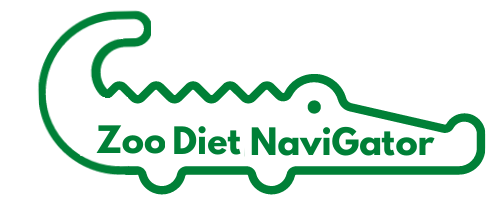Groupings
From ZDN User Guide
In general, it is best practice to prepare diets the way they are fed. If the animals are fed as a group, the diet should be prepared as a group. If the animals are fed individually, diets should be weighed and prepared individually. We try to avoid situations where we carefully prepare individual diets only to have the keepers put everything together in a pan, or to send bulk food and then the keepers spend time portioning it out. It is most efficient to handle/weigh/prepare the food once rather than multiple times.
ZDN has two(ish) methods of grouping animals:
- Herd (or flock) diets: one diet plan multiplied by the number of animals. Generally, each animal is considered to have a value of 1. So, for example if your flock of 50 flamingos each gets ~100 g of flamingo food a day, you could create a diet for 100 g and assign 50 birds to that diet for a total of 5000 g. However you can set the value (Animal Units) of an animal to be less (a smaller animal) or more (a growing/pregnant/lactating animal) than 1 if needed. If one bird is small, you might set that animal to be worth 0.5 animal units, and then you'd have 49.5 "animals", for a amount of 4950 g.
- Grouped diets: multiple diets combined together. For example, in one pond you have ducks (who eat duck food), geese (who eat goose food), and swans (who eat swan food) who are fed together out of the same pans. You can place these three diets together in a Group. The summed diet (duck + goose + swan food) will be what is prepared as a single diet, but you can still maintain the three types of diets separately, which makes it easier when birds move around or you want to see the diet history.
Here are some examples of how to apply Herds and Groups in practice:
- A group of 4 similar zebra fed together - Create 1 diet with the amounts for 1 animal. Add all 4 animals to the diet (on the Edit Diets > Animals & Enclosures tab). The group amount will change to reflect 4x the single diet.
- A group of 4 similar zebra fed together. One zebra gets an additional "treat" for taking medication:
- Option 1: Create 1 diet with the amounts for 1 animal. Add all 4 animals to the diet (for the diet they have in common). Create a second diet with just the additional treat and assign the medicated animal to that diet (will generate 2 separate diets for that group).
- Option 2: Create 1 diet with the amounts for 1 animal. Add the 3 non-medicated animals to that diet. Copy the diet items. Create an additional diet for the medicated zebra. Paste in the diet items. Add in the medication treat. This will also generate 2 separate diets for the zebras.
- Option 3: Same as options 1 or 2, but create a Group called "Group of 4 zebras" and assign both diets to that group. This will generate one combined prep for the zebra group containing all the foods from the two diets.
- A group of 4 adult zebras, plus a newborn foal - Create 1 diet with the amounts for 1 animal. Add all 5 animals to the diet. Set mom's Animal Units to 1.4 to account for early lactation. Set foal to 0 Animal Units for now. In a few weeks, set foal to 0.5 Animal Units and perhaps increase mom to 1.8 Animal Units.
- A group of 4 gorillas fed together as a family - one 3-year-od, one adult lactating female (mom), one adult female, one silverback male.
- Option 1: Create 4 separate diets (one for each animal). Create a group called "Gorilla Family" and assign each of the four diets to belong to this group. This will allow you to maintain separate diet histories and individualized diet plans for each animal.
- Option 2: Create 1 gorilla diet. Assign all four animals to this diet. Assign Animal Units as 0.5 (baby), 1.2 (mom - late lactation), 1 (adult female), 1.5 (silverback).
